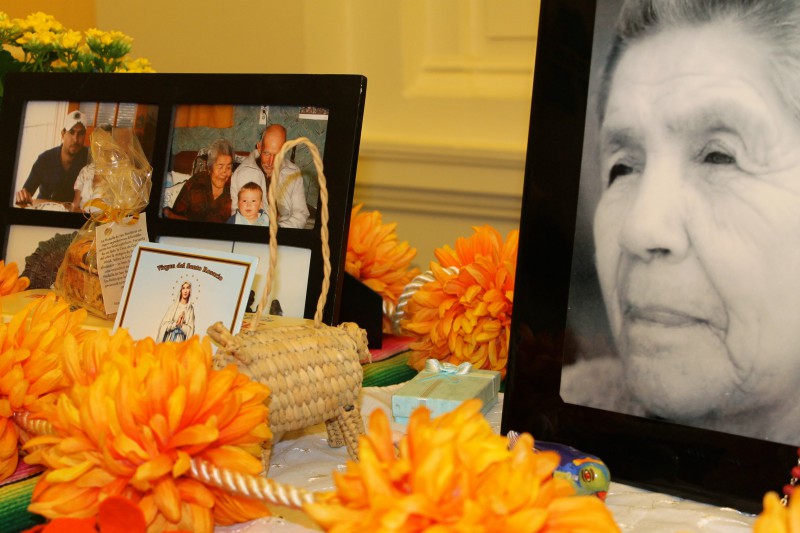Grand Rapidians celebrate Day of the Dead
A collection of Day of the Dead altars celebrate the Mexican holiday at Grand Rapids Public Library.

Day of the Dead at the Library
Altars created by Grand Rapidians for Day of the Dead are on view through Sunday on the third floor of the main library downtown Grand Rapids Hours at the library are Friday and Saturday 9 am to 6 pm; Sunday 1 to 5. Music and refreshments are part of the celebration.
Day of the Dead, despite its somber name, is a big, colorful and fun celebration of life. Each year on November 1 to 2, Mexicans, Mexican Americans and an increasing number of everyone else enjoy remembering loved ones who have died.
Eva Aguirre Cooper has been celebrating Day of the Dead or in Spanish, Dia de Los Muertos. "It is a celebration of the memories of those who have passed on. In many Mexican homes, you'll often see a small altar to honor those who have passed on. It might have a photograph, a Virgin Mary, a candle or flowers. That's on a small scale, but on Dia de Los Muertos it is more of a huge commemoration. I can remember doing huge altars with my mom with all kinds of pictures, tokens, flowers, pictures of the saints and everything," said Aguirre Cooper. She's also traveled to Mexico during Day of the Dead. "People go right into the cemetaries and decorate the graves, place flowers and candles and play music. It isn't at all a morbid thing. It is always about celebrating the lives of people and [being] creative. I think in the Mexican culture we look at death a lot differently. It isn't something we fear or are stand-offish about. There is much more openness about death and I think people are curious about that." She thinks that the openess about death is appealing to people who want to remember their loved one. Aguirre Cooper will celebrate the day at her home with a party for friends and together they will create an ofrenda or altar. "The act of making the ofrenda is therapeutic."
Emily and Sergio Lopez created an altar at the Grand Rapids Public Library to honor Sergio's grandmother. "Mexican culture is so much more open about the way they remember loved ones and deal with death than we are in the U.S. There is a famous saying Viva la vida which translates to live life. It very symbolic of life in Mexico - there are always celebrations. For my family it's a great time to focus on a loved one who has died and a purposeful way to share memories about that person. It's very important to my husband and I that our sons know their heritage and celebrating family members is a great way to help them learn," said Emily Lopez.
The holiday is a mashup of pagan tradition mixed with Catholicism, she said. It has been practiced for at least 3,000 years and despite the efforts of Spaniards and missionaries to end it, the tradition carried on.
Often food, drink and flowers are placed on the altars. "Food in case the souls are hungry, drink for thirst and flowers to welcome them," said Aguirre Cooper. Celebrations and altars can also include tequila, toys for children who have died and pillows so souls have a place to rest after the long journey back home. The Lopez family has created an altar for Abuelita Adelaida, Sergio’s grandmother who died in 2008. “We will have some photos of her, candles, flowers, banners, Mexican flags to show she loved her country, a carton of eggs because she had some egg dishes she was famous for, pan dulce or Mexican sweet breads that she loved and a few other personal items that belonged to her or help us remember her," said Lopez.
Humans aren't the only loved ones remembered at Day of the Dead celebrations. Pets are honored, too. Many people feel that animals are kindred spirits and honor them with altars. There are several animal altars at the library display. One was created by Emily Sazima and Liz Seelye whose parrots and parakeets were victims of poisoning by a former housemate.
They made paper mache skulls on which they painted images of the birds. Marigolds also decorate the altar. "They are known as the flowers of the dead and the smell is supposed to appeal to the spirits.The altar itself is in the shape of a cabinet, or doorway, which symbolized the door between life and death," said Sazina. The back of the altar is a painting of St. Therese of the Little Flower, representing some of Sazima's personal beliefs. Finally, they have water and food offerings for the parrots. "Our African Grey parrot LOVED pistachios, so we will definitely put the pistachios out as an offering, and probably some bird seed and popcorn. Parrots love popcorn," said Sazima. Creating the altar helped the friends channel some of the grief and frustration of the birds' death into something positive.

A core service of the Grand Rapids Community Media Center




